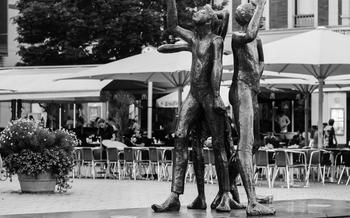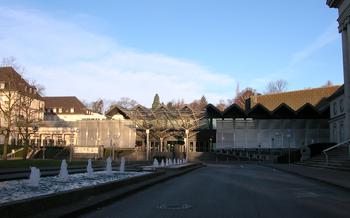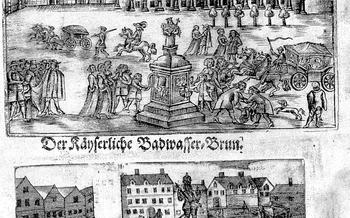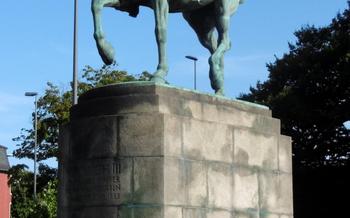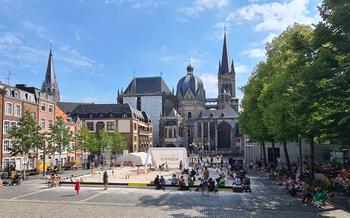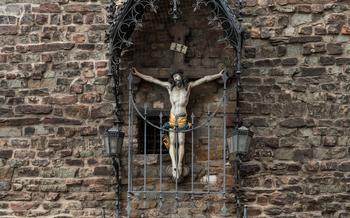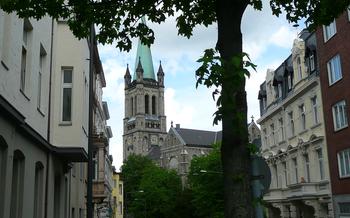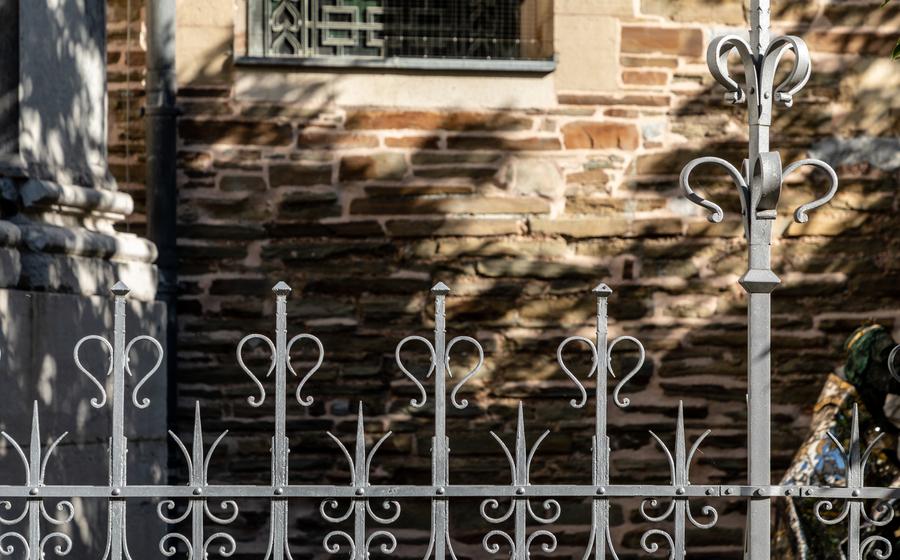
Westfriedhof Aachen (West Cemetery)
- The Westfriedhof Aachen (West Cemetery): A Haven of History and Serenity
- History
- Architecture
- Monuments
- Notable Burials
- Exploring the Grounds: Nature, Art, and Remembrance
- The Chapel: A Sacred Space for Reflection
- World War Memorial: Honoring the Fallen
- Sculpture of the Grieving Widow: A Symbol of Loss
- Notable Burials: Remembering the Legends
- Guided Tours: Unveiling the Stories
- Photography and Videography: Capturing Memories
- Visiting Hours and Accessibility
- Events and Commemorations: Honoring Memories at the Westfriedhof
- Combining History and Nature: Nearby Attractions
- Recommended Tours and Itineraries
- Tips for a Meaningful Visit
- Insider Tip: Hidden Gems
The Westfriedhof Aachen (West Cemetery): A Haven of History and Serenity
Established in 1816, the Westfriedhof Aachen (West Cemetery) stands as a testament to the rich history of Aachen, Germany. This sprawling cemetery is not merely a place of eternal rest; it is a haven of tranquility, a sanctuary of remembrance, and a repository of stories that echo through time. As you step through its gates, you enter a realm where nature, art, and history intertwine, inviting you to explore the lives and legacies of those who have shaped the tapestry of Aachen's past.
History
The Westfriedhof was conceived during a time of profound change in Aachen, when the city was transitioning from a medieval stronghold to a burgeoning industrial hub. The need for a new cemetery arose, one that would reflect the city's growing prominence and provide a dignified resting place for its citizens. Thus, the Westfriedhof was born, designed in the Neoclassical style that was then in vogue.
Architecture
The Westfriedhof's Neoclassical architecture is a testament to the prevailing aesthetics of the early 19th century. The cemetery's centerpiece is the chapel, a solemn and elegant structure that dominates the grounds. Its clean lines, symmetrical proportions, and imposing facade create an atmosphere of reverence and tranquility. The chapel's interior is equally impressive, featuring intricate stained-glass windows, frescoes, and sculptures that depict scenes from the Bible.
Monuments
The Westfriedhof is home to several notable monuments that pay tribute to those who have served and sacrificed for their country. The most prominent among these is the war memorial, a towering obelisk that commemorates the lives lost in World War I and World War II. Another poignant monument is the sculpture of the grieving widow, a heart-wrenching depiction of a woman lost in sorrow, created by the renowned sculptor Joseph Mengelberg.
Notable Burials
Throughout its history, the Westfriedhof has become the final resting place for many notable figures who have left an indelible mark on Aachen's cultural, political, and industrial landscape. Among them are Karl Friedrich Schinkel, a renowned architect; Friedrich Wilhelm Joseph Schelling, a prominent philosopher; and several influential industrialists who played a pivotal role in shaping the city's economic growth.
Exploring the Grounds: Nature, Art, and Remembrance
The Westfriedhof is not just a resting place for the deceased; it is also a beautiful and serene park, inviting visitors to wander and contemplate. Wander through the meticulously maintained gardens, where colorful flowers bloom in profusion and manicured lawns stretch out like a verdant carpet. Admire the exquisite sculptures that grace the grounds, each a unique tribute to the departed. These works of art, ranging from classical statues to modern abstract pieces, add a touch of elegance and contemplation to the cemetery.
Explore the elaborate mausoleums that serve as final resting places for notable families. These grand structures, often adorned with intricate carvings, stained-glass windows, and marble sculptures, reflect the wealth and prestige of the families they represent. Take time to understand the symbolism behind the various elements found throughout the cemetery. From the weeping willows that represent mourning to the doves that symbolize peace, each element holds a deeper meaning, adding to the rich tapestry of the Westfriedhof's history and significance.
The Chapel: A Sacred Space for Reflection
The Westfriedhof Aachen is home to a striking Neoclassical chapel that serves as a sacred space for reflection and remembrance. The chapel's exterior features elegant columns, intricate carvings, and a grand entrance that invites visitors to step inside.
Once inside, visitors are greeted by a serene and awe-inspiring atmosphere. The chapel's interior is adorned with intricate stained-glass windows that depict biblical scenes and religious symbols. Frescoes and sculptures grace the walls and ceiling, adding to the chapel's ethereal beauty.
The altar is the focal point of the chapel, where religious ceremonies and services are held. It is a magnificent work of art, featuring intricate carvings, gold leaf decoration, and a stunning altarpiece that depicts a religious scene.
The chapel has a rich history, having served the community for over a century. It has witnessed countless moments of grief, reflection, and remembrance. Today, it continues to be a place where visitors can come to pay their respects to loved ones, seek solace in times of sorrow, or simply find a moment of peace and tranquility amidst the hustle and bustle of city life.
World War Memorial: Honoring the Fallen
Established in the aftermath of the First World War, the war memorial at the Westfriedhof serves as a poignant tribute to those who lost their lives in both World Wars. The memorial is a grand and imposing structure that commands attention with its solemn presence. Designed by the renowned architect Ludwig Becker, the memorial is a testament to the skill and artistry of the period.
With its soaring obelisk and intricate carvings, the memorial is a powerful symbol of remembrance and honor. The names of the fallen are inscribed on the memorial's surface, creating a lasting record of their sacrifice. Each name represents a life cut short, a family torn apart, and a community forever changed by the ravages of war.
Visitors to the war memorial are often struck by its somber beauty and the weight of the sacrifice it represents. The memorial serves as a reminder of the devastating toll of war and the importance of remembering those who have given their lives for their country. It is a place for reflection, remembrance, and a renewed commitment to peace.
The memorial is a place of pilgrimage for families and friends of those who lost their lives in the wars. They come to pay their respects, to remember their loved ones, and to find solace in the shared experience of grief. The memorial also serves as a reminder of the importance of peace and the need to prevent future conflicts.
Sculpture of the Grieving Widow: A Symbol of Loss
In a secluded corner of the Westfriedhof, a poignant sculpture known as the Grieving Widow stands as a testament to the universal experience of loss. Crafted by the renowned artist Joseph Mengelberg, this sculpture is a masterpiece of emotional expression. The grieving widow is depicted with her head bowed in sorrow, her body draped in flowing robes that seem to convey the weight of her grief. The intricate details in the sculpture, from the delicate folds of her clothes to the tear-streaked face, evoke a sense of profound empathy and compassion.
The Grieving Widow symbolizes the shared experience of loss that unites people across cultures and time. It serves as a reminder of the pain and sorrow that accompanies the death of a loved one. The sculpture invites visitors to reflect on the fragility of life and the enduring power of grief.
Mengelberg's sculpture has become an iconic symbol of the Westfriedhof. It has been featured in numerous publications and guidebooks, and it continues to draw visitors from around the world who come to pay their respects and contemplate the mysteries of life and death.
Notable Burials: Remembering the Legends
The Westfriedhof Aachen serves as the final resting place for numerous prominent individuals who have made significant contributions to various fields. Among the most notable burials are:
-
Karl Friedrich Schinkel (1781-1841): A renowned Prussian architect, urban planner, and painter, Schinkel is celebrated for his Neoclassical designs and his role in shaping the architectural landscape of Berlin.
-
Friedrich Wilhelm Joseph Schelling (1775-1854): A German philosopher and one of the most influential figures of the Romantic movement, Schelling's work explored the relationship between nature, art, and the human spirit.
-
Friedrich von Delius (1862-1934): A British composer of German descent, Delius is known for his evocative orchestral works and operas that often drew inspiration from the English countryside.
-
Walter Kaesbach (1879-1961): A German architect and city planner, Kaesbach is remembered for his contributions to the urban development of Aachen, including the design of several notable buildings and public spaces.
-
Lou van Burg (1912-1987): A Dutch-American actress and singer, van Burg achieved fame in the United States during the Golden Age of Hollywood, starring in numerous films and television shows.
Exploring the graves of these notable individuals offers a glimpse into the rich history and cultural heritage of Aachen and beyond. Each burial site tells a unique story, inviting visitors to reflect on the lives and achievements of those who have left an indelible mark on society.
Guided Tours: Unveiling the Stories
To delve deeper into the captivating history and symbolism of the Westfriedhof Aachen, guided tours are available to enhance your visit. These tours, led by knowledgeable and experienced guides, provide an immersive experience that unveils the stories behind the monuments, sculptures, and notable burials that grace the cemetery.
The guided tours cover a range of themes, allowing visitors to tailor their experience based on their interests. From delving into the lives of prominent historical figures and cultural icons to exploring the symbolism and significance of the various monuments, these tours offer a unique perspective on the Westfriedhof's rich heritage.
During the tours, visitors will discover hidden gems and lesser-known tales that bring the cemetery's history to life. Guides share insights into the symbolism behind the sculptures, the stories behind the elaborate mausoleums, and the impact of the individuals who found their final resting place at the Westfriedhof.
Whether you're a history buff, an art enthusiast, or simply seeking a deeper understanding of the Westfriedhof, guided tours provide an enriching and memorable experience. Book your tour in advance to secure your spot and immerse yourself in the fascinating narratives that unfold within the walls of this historic cemetery.
Photography and Videography: Capturing Memories
The Westfriedhof Aachen embraces the power of photography and videography as a means to immortalize the stories and significance of its sacred grounds. However, to ensure the utmost respect for the departed and the solemnity of the cemetery, certain regulations and etiquette must be observed.
Regulations:
- Obtain Permission: Before capturing any images or footage, it is essential to seek permission from the cemetery's administration. This ensures compliance with privacy regulations and the protection of the rights of the deceased and their families.
- Respect Privacy: Refrain from photographing or filming individuals without their consent, especially those grieving or visiting the cemetery for personal reasons.
- Avoid Disruption: Be mindful of ongoing ceremonies, services, or gatherings. Choose unobtrusive angles and maintain a respectful distance to avoid disturbing the tranquility of the cemetery.
Etiquette:
- Dress Appropriately: When photographing or filming in a cemetery, it is crucial to dress in a respectful manner. Avoid attire that is overly casual or revealing, as it may be seen as disrespectful to the departed.
- Silence and Tranquility: Maintain silence and tranquility while capturing images or footage. Avoid loud conversations, laughter, or any behavior that may disrupt the peaceful atmosphere of the cemetery.
- Composition and Storytelling: Consider the composition of your images and videos to convey the beauty, history, and stories of the Westfriedhof. Use lighting, angles, and framing to create compelling narratives that honor the legacy of the deceased.
Visiting Hours and Accessibility
The Westfriedhof Aachen is open to the public daily from 8 am to 6 pm. Guided tours are available upon request and can be booked in advance through the cemetery's office. Visitors with disabilities can access the cemetery through designated entrances and utilize wheelchair-accessible paths throughout the grounds.
To reach the Westfriedhof, visitors can take public transportation, with the nearest bus stop located just a short walk away. For those arriving by car, ample parking is available in the vicinity of the cemetery. Please note that parking fees may apply.
Events and Commemorations: Honoring Memories at the Westfriedhof
The Westfriedhof serves as a venue for various events and commemorations that honor the departed and celebrate their lives. These events provide opportunities for remembrance, reflection, and community engagement.
Memorial Services: Throughout the year, memorial services are held at the Westfriedhof to honor those who have passed away. These services often include readings, prayers, and music, and serve as a time for families and friends to come together and remember their loved ones.
Cultural Events: In addition to memorial services, the Westfriedhof also hosts cultural events and exhibitions that explore the history, art, and significance of the cemetery. These events offer visitors a chance to learn more about the cemetery's unique heritage and its role in the community.
Remembrance Days: Special days of remembrance are observed at the Westfriedhof to honor those who have made significant contributions to society or who have been affected by historical events. These days may include ceremonies, wreath-laying, and other commemorative activities.
Participation: Visitors to the Westfriedhof are encouraged to participate in events and commemorations to show their respect and remembrance for those buried there. This can be done by attending memorial services, contributing to the upkeep of the cemetery, or simply taking the time to learn about the stories and lives of those who have been laid to rest.
Combining History and Nature: Nearby Attractions
The Westfriedhof Aachen is surrounded by a wealth of historical and natural attractions that enhance the experience of visiting this serene cemetery. A short walk away lies the magnificent Aachen Cathedral, a UNESCO World Heritage Site and one of the most significant architectural landmarks in Germany. Its stunning Gothic spires and intricate interior frescoes are a testament to the city's rich history and religious heritage.
For a relaxing and rejuvenating experience, head to the Carolus Thermen, a renowned thermal bath complex located just a few minutes from the Westfriedhof. Indulge in the healing waters of the thermal springs and enjoy the various saunas, steam baths, and relaxation areas.
Another nearby attraction is the Elisenbrunnen, an iconic fountain with healing mineral water. Situated in the heart of Aachen's spa district, the Elisenbrunnen is a popular spot for visitors to sample the city's renowned thermal waters.
Nature lovers will appreciate the Botanical Garden, home to a diverse collection of plants from around the world. Located a short distance from the Westfriedhof, the Botanical Garden offers a peaceful retreat with its serene ponds, lush greenery, and colorful flower displays.
Recommended Tours and Itineraries
To make the most of your visit to the Westfriedhof Aachen, consider exploring it through self-guided or guided tours. For a personalized experience, create your own itinerary and stroll through the cemetery at your own pace. Discover the stories behind the monuments, sculptures, and notable burials, immersing yourself in the rich history and symbolism of the place.
Guided tours are an excellent option to learn more about the cemetery's significance and uncover hidden stories. These tours often provide insights into the lives of the famous personalities buried here and the symbolism behind the various elements found throughout the Westfriedhof. They also offer a deeper understanding of the history and cultural heritage of Aachen.
If you're interested in combining your visit to the Westfriedhof with other attractions in Aachen, consider booking a combination tour. These tours typically include visits to the Aachen Cathedral, Carolus Thermen, Elisenbrunnen, or the Botanical Garden, allowing you to experience the diverse cultural and historical offerings of the city.
Plan for an appropriate amount of time to fully experience the Westfriedhof. Set aside at least an hour to wander through the grounds, admire the monuments, and reflect on the stories of those buried here. If you're joining a guided tour, the duration may vary, so check the tour details beforehand to ensure you have enough time to explore the cemetery at your leisure.
Tips for a Meaningful Visit
To make the most of your visit to the Westfriedhof Aachen, consider these tips:
-
Research: Before your visit, take some time to learn about the history of the cemetery and the notable individuals buried there. This will help you appreciate the significance of the place and the stories behind the graves.
-
Reflection: The Westfriedhof is a place of remembrance and reflection. Take some time to pause and reflect on the lives and stories of those buried there. Consider what their lives were like, their accomplishments, and their contributions to society.
-
Remembrance: If you have ancestors or loved ones buried at the Westfriedhof, take a moment to pay your respects by placing flowers or lighting a candle at their graves. This is a meaningful way to honor their memory and show your gratitude for their lives.
-
Gratitude: The Westfriedhof is home to the graves of many individuals who have made significant contributions to history and culture. Take some time to express your gratitude for their work and the impact they have had on the world.
Insider Tip: Hidden Gems
Beyond the main paths of the Westfriedhof, there lies a hidden garden that offers a tranquil oasis away from the hustle and bustle of the cemetery. Seek out this secluded spot to find a moment of peace and reflection. As you wander through the cemetery, take the time to read the epitaphs on the graves. These inscriptions often reveal unique and touching stories about the lives of those buried here. Explore the lesser-known paths to discover hidden monuments and sculptures that may have been overlooked by other visitors. Engage with locals who frequent the Westfriedhof, as they may share their own experiences and stories related to this historic site.

